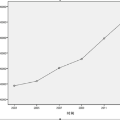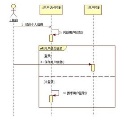In this work, we present a novel trajectory comparison algorithm to identify abnormal vital sign trends, with the aim of improving recognition of deteriorating health. There is growing interest in continuous wearable vital sign sensors for monitoring patients remotely at home. These monitors are usually coupled to an alerting system, which is triggered when vital sign measurements fall outside a predefined normal range. Trends in vital signs, such as increasing heart rate, are often indicative of deteriorating health, but are rarely incorporated into alerting systems. We introduce a dynamic time warp distance-based measure to compare time series trajectories. We split each multi-variable sign time series into 180 minute, non-overlapping epochs. We then calculate the distance between all pairs of epochs. Each epoch is characterized by its mean pairwise distance (average link distance) to all other epochs, with clusters forming with nearby epochs. We demonstrate in synthetically generated data that this method can identify abnormal epochs and cluster epochs with similar trajectories. We then apply this method to a real-world data set of vital signs from 8 patients who had recently been discharged from hospital after contracting COVID-19. We show how outlier epochs correspond well with the abnormal vital signs and identify patients who were subsequently readmitted to hospital.
翻译:在本研究中,我们提出了一种新的轨迹比较算法,以识别异常的生命体征趋势,旨在提高衰退健康识别。越来越多的人对家庭远程监视患者的连续穿戴生命体征传感器感兴趣。这些监视器通常与警报系统配对,当生命体征测量超出预定义的正常范围时触发。生命体征趋势,例如心率升高,通常表明健康恶化,但很少纳入警报系统中。我们介绍一种基于动态时间扭曲距离的测量方法来比较时间序列轨迹。我们将每个多变量标志时间序列分成180分钟,不重叠的时代。然后计算所有时期之间的距离。每个时代都以其与所有其他时代的平均链接距离(平均链接距离)为特征,形成附近时代的簇。我们在合成生成的数据中展示了这种方法可以识别异常时期并聚集轨迹相似的时期。然后,我们将此方法应用于8名刚从医院出院的COVID-19患者的真实生命体征数据集。我们展示了异常时期如何与异常生命体征相对应,并识别了随后重新入院的患者。


